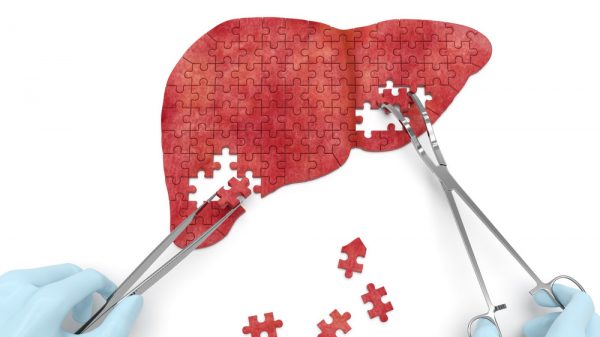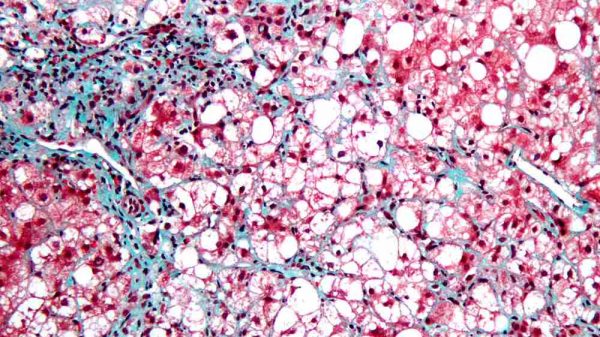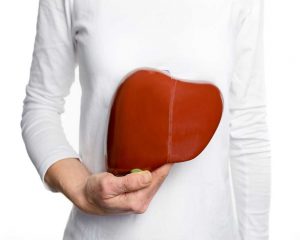Laennec’s cirrhosis is a liver condition that makes the liver surface have a nodular appearance. This type of cirrhosis is linked with alcoholism. Each time the liver gets injured by whatever means whether by excess alcohol intake or by disease – it attempts self-repair, and during the process, scar tissues are formed and affect the function of the liver (decompensated cirrhosis).
In 1819, a man named Rene Laennec introduced the word cirrhosis (meaning brownish yellow or tawny) to the world. He used this term in a short footnote he wrote about auscultation.
Rene Laennec’s major contribution to the field of medicine has to do with chest conditions. This is the same person who invented the stethoscope. For a while, the word cirrhosis was not taken seriously until it was mentioned in William Osler’s Principles and practices of medicine where he tagged it as “cirrhosis of Laennec”
Symptoms
Most damage done by cirrhosis to the liver is irreversible, but with early diagnosis, its cause may be treated, thus stopping further damage.
Cirrhosis would usually not show any symptom or sign until extensive damage has been done.
If at all there are any signs or symptoms, then it could include:
- Easy bruising or bleeding
- Fatigue
- Nausea
- Lack of appetite
- Swelling in the legs, ankles, or feet
- Itchy skin
- Weight loss
- Jaundice
- Accumulation of fluid in the abdomen
- Blood vessels that look like spider visible on the skin
- Red palms
- Loss or absence of periods (unrelated to menopause)
- No sex drive in men and their breast gets bigger or testicles atrophy
- Drowsiness, confusion, and impaired or slurred speech.
Causes or Risk Factors of Laennec’s Cirrhosis
Excessive alcohol intake can damage your liver and is the main cause of Laennec’s cirrhosis
Possible Complications of Cirrhosis
The complications that can arise from cirrhosis include:
Portal hypertension
This describes the pressure increase in all veins that carries blood to the liver. Due to cirrhosis, the normal blood flow through the liver declines, thus increasing the pressure within the portal veins.
Abdomen and legs swelling
When the pressure of the portal vein increases, it can lead to the accumulation of fluid in both legs, known as edema, and the abdomen known as ascites. Both of these situations may be the effect of the liver’s inability to produce enough specific blood proteins like albumin.
Spleen enlargement
Portal hypertension may lead to swelling and changes in the spleen, thus trapping the blood cells (white) and platelets. A decreased amount of platelets and WBCs in the blood can be cirrhosis first sign.
Bleeding
Because of portal hypertension, the direction of your blood may change, leading it through smaller veins. Since the smaller veins are not able to withstand such pressure, it can burst and would lead to severe bleeding. The veins in the esophagus may get enlarged (varies) or the veins of the stomach enlarged (gastric varices) due to this portal hypertension and bleeding, which may be life-threatening.
Infections
A body with cirrhosis may not be able to fight infections. Bacterial peritonitis may arise from ascites, and this is a severe infection.
Malnutrition
Cirrhosis can make digestion difficult. Your body will not be able to process the nutrients, causing weight loss and weakness.
Toxin buildup in your brain
Damaged liver due to cirrhosis will not be able to clear off the blood toxins as a well functioning liver can. If the brain accumulates these toxins, it can lead to loss of concentration or mental confusion. Gradually this build-up can develop into coma or unresponsiveness.
Jaundice
It occurs in an unhealthy liver that is unable to remove the waste product, bilirubin from the blood. Skin and eyes can turn yellow, or the urine is darkened.
Bone disease
Cirrhosis may lead to loss of bone strength, increasing the chances of fractures. Liver cancer can also come out from liver cirrhosis. A high percentage of people who are suffering from liver cancer already had cirrhosis.
Chronic cirrhosis can lead to multiorgan failure. More research is to be conducted for more understanding of how this works.
Prevention
The risk of a person getting cirrhosis can be reduced if steps are taken to care for the liver. You can take care of the liver by limiting or cutting away alcohol from your lifestyle. A healthy diet also helps, consume mostly plant-based foods like vegetables and fruits. Opt for lean protein sources and whole grains. Cut down fried and fatty food intake.
Your weight is also important, because too much body fat may damage the liver. If you are unsure of how to go about controlling your weight, consult a doctor, there are also several guides you can find on the internet that helps people through a weight loss journey.
In conclusion, Laennec’s cirrhosis is best avoided by staying away from alcohol completely, as this is its cause. A healthy lifestyle will not only benefit your liver, but you will see its results in all your overall health.
If you already drink a lot of alcohol, then stop. It might be a difficult process, but get all the help you need because it will pay you in the long run.
























